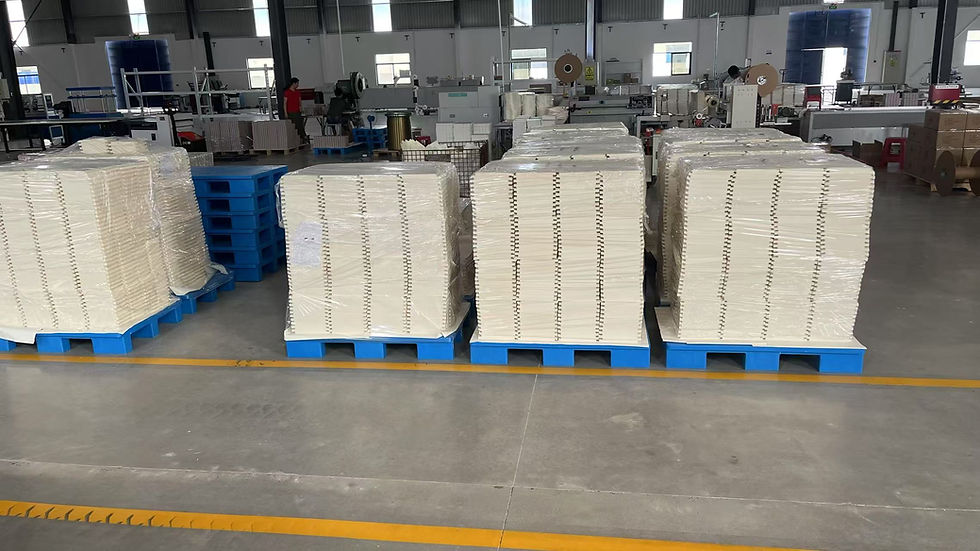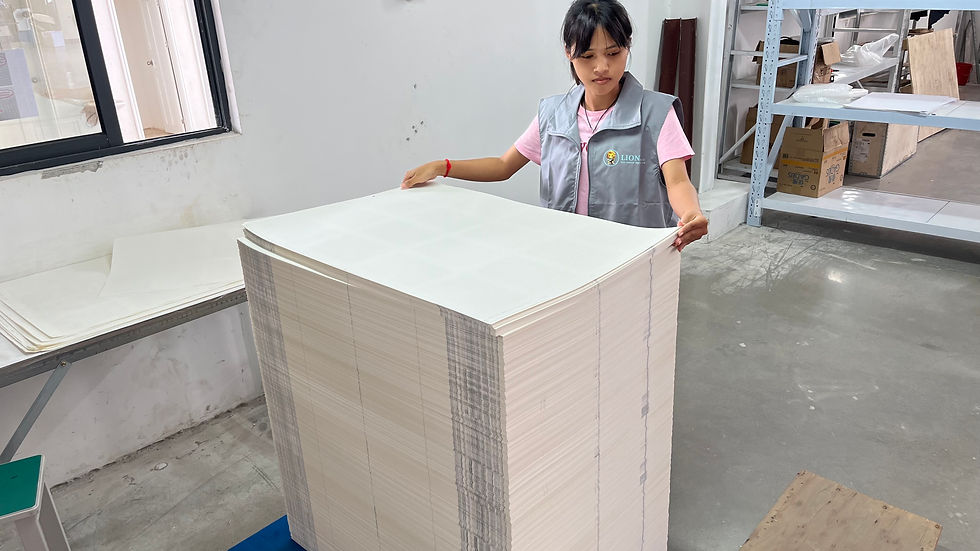How to Control Humidity to Protect Notebook Product Quality
- Leo Xia

- Jun 2
- 4 min read
Updated: Jun 3
Quick Content Reach:
In the paper stationery industry, quality is everything. But in humid climates—especially during rainy seasons across China and Southeast Asia—maintaining paper stability is a science. After more than two decades of supplying custom paper notebooks, planners, and journals to clients in the U.S., U.K., and beyond, I can confidently say: mastering moisture control is not optional. It’s a foundational part of delivering reliable, high-quality products.
Control Humidity Matters in Stationery Manufacturing
Paper is a living material. It absorbs and releases moisture depending on its environment. Without proper control, high humidity can lead to:
Wavy or curled pages
Smudged or misaligned prints
Binding misfits due to size fluctuations
Mold growth in packaging
Each of these can destroy the value of a beautifully designed notebook. That’s why at Lion Paper, we developed a rigorous humidity control protocol for every step from production in Jiaxing, China to final delivery at our Cambodia factory.

Step 1: Controlling Humidity in Production (Jiaxing, China)
Standard Operating Conditions:
Humidity: 50% to 60% RH
Temperature: 20–25℃
Equipment: 24/7 industrial dehumidifiers during rainy seasons (especially the "Meiyu" plum rain season)
Moisture Testing:
All printed semi-finished goods are tested within 2 hours post-printing using paper moisture meters.
Acceptable paper moisture content: 6% to 8%
Storage Handling:
No open-air stacking during rainy days
Semi-finished products immediately transferred to climate-controlled warehouses with continuous data logging (target humidity: ≤65%)

Step 2: Packaging with Built-In Moisture Defense
Three-Layer Protection:
Inner Layer: PE moisture-proof bag or aluminum foil bag (≥80μm), heat-sealed
Middle Layer: Waterproof corrugated boxes (moisture ≤10%) with kraft + PE film lining
Outer Layer: Stretch film (≥25μm) in “cross-wrapped” pattern: 3 layers top/bottom, 5 on sides
Desiccant Use:
Silica gel packed in small bags, evenly distributed
Humidity indicator cards trigger replacement at >60%

Step 3: Domestic and Overseas Transport Monitoring
Domestic (Jiaxing to Port)
Fully enclosed truck trailers, base padded with plastic pallets and PE film
Moisture-proof vehicle inspection before departure
Delivery time around 6 hours
Sea Freight (China to Cambodia)
40-foot dry container, cleaned and inspected for leaks before loading
10 dry pole desiccants (≥1kg each) per container
Leave ≥10cm spacing from container wall; top clearance for air flow
“Bricklay” stacking for stability

Step 4: Arrival and Acclimatization in Cambodia
Unloading:
Indoor unloading to avoid exposure to dry season air
Forklift handling with care to avoid package damage
Temporary Storage:
Store in humidity-adjusted(drying room) warehouse (55%–65% RH)
Ensure ventilation, avoid strong air flow on goods
Unpacking Protocol:
Rest ≥48 hours before unpacking to equalize moisture
Inspect packaging for signs of moisture or damage
Post-unpacking moisture test:
<5%: humidify for 24 hours
9%: ventilate dry until standard met


Step 5: Pre-Production Preparation in Phnom Penh
Move semi-finished goods into printing area 2 hours before operation
Room RH: 50%–60%, Temp: 28–32℃
Daily sample check (5% of goods) for flatness/waviness
3% defect rate triggers re-conditioning cycle

Implementation Checklist
Best Practices & Insights
Moisture barrier first: Packaging seal > desiccant > environment
RH adaptation limit: RH change ≤ ±2% between stages
Quarterly staff training: Cross-site training every 3 months
Emergency room equipped: Conditioning room for 72h correction

Final Thoughts: Quality Starts With Climate Awareness
Humidity isn’t a side note in paper goods manufacturing—it’s a critical variable. At Lion Paper, we treat it as such. Every process, every shipment, every product you receive from us is backed by this quiet but powerful system of environmental control. We do it not just to meet spec, but to ensure your brand reputation is never compromised.
Want to learn more about how we can customize notebook production for your climate and shipping conditions?
Contact us now: https://www.lionpaper-istyle.com/contact
—Leo Xia, CEO, Lion Paper Products
FAQs:
Q1: How does high humidity affect notebook quality?
A: It causes paper warping, blurred printing, binding misalignments, and potential mold—especially during long-distance transport or storage.
Q2: What is the ideal paper moisture content during production?
A: 6% to 8%. Lion Paper uses moisture meters to test every batch of semi-finished goods within 2 hours after printing.
Q3: How does Lion Paper protect products during rainy season transport?
A: We use sealed trucks, plastic pallet bases, and stretch-wrapped cartons, plus container desiccants and real-time RH tracking.
Q4: What kind of packaging do you use to prevent moisture damage?
A: Three-layer protection: PE or foil bags (inner), waterproof corrugated boxes with liners (middle), and stretch film wrap (outer).
Q5: How do you ensure humidity stability during sea shipping to Cambodia?
A: Each container is fitted with 10 desiccant poles, airflow gaps, and remote sensors. Alerts trigger pre-arrival conditioning.
Q6: Can your factory handle very dry conditions in Cambodia's dry season?
A: Yes. We store goods in a humidity-adjusted warehouse and acclimatize them for 48 hours before unpacking to avoid cracking or shrinkage.
Q7: How long does it take to balance humidity after goods arrive?
A: Typically 24–48 hours, depending on moisture readings. Paper below 5% moisture is rehumidified, above 9% is dried.
Q8: How can I be sure your moisture control really works?
A: Our entire quality inspection process is recorded with bodycams, and all paper is tested pre- and post-transport. We offer detailed humidity records upon request.
Are you looking for a reliable manufacturer? Reach out to Lion Paper for a free quote and consultation. Let’s collaborate on creating custom writing paper products that will set your brand apart from the competition.






Comments